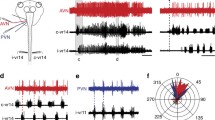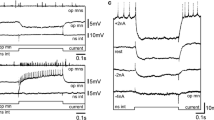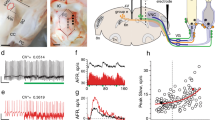Summary
In electric fish of the family Mormyridae some primary afferent fibers conduct impulses not only from electroreceptors to the brain but also from the brain to the receptors. The efferent impulses may be elicited by electrical stimulation which is within the physiological range, i.e., by stimulation which is similar in amplitude and duration to the stimulation that is caused by the fish's own electric organ discharge. Afferent and efferent impulses in the same afferent fiber were identified by: simultaneously recording from a fiber at two different points, at the receptor and at the nerve trunk (Figs. 2C-H; 3B-D); by cutting the afferent fiber between the brain and the recording site as well as between the recording site and the periphery; and by intra-axonal recording from the afferent fiber near its entry into the brain (Fig. 4). The efferent impulses result from the central integration of a corollary discharge of the electric organ motor command with excitatory and inhibitory input from several different receptors near the one from which afferent impulses originate (Fig. 4). The centrally originating impulse may be capable of modifying the effect of signals originating in the periphery.
Similar content being viewed by others
Abbreviations
- ELLL :
-
electrosensory lateral line lobe
- EOCD :
-
electric organ corollary discharge
- EOD :
-
electric organ discharge
- epsp :
-
excitatory postsynaptic potential
- NPLL:
-
posterior lateral line nerve
References
Baker R, Llinás R (1971) Electrotonic coupling between neurons in the rat mesencephalic nucleus. J Physiol (Lond) 212:45–63
Bell CC, Russell CJ (1978) Termination of electroreceptor and mechanical lateral line afferents in the mormyrid acousticolateral area. J Comp Neurol 182:367–382
Bennett MVL (1965) Electroreceptors in mormyrids. Cold Spring Harbor Symp Quant Biol 30:245–262
Bennett MVL (1971) Electroreception. In: WS Hoar, DS Randall (eds) Fish physiology. Academic Press, New York, pp 493–574
Brooks C McC, Koizumi K (1956) Origin of the dorsal root reflex. J Neurophysiol 18:61–73
Casey KL, Oakley B (1972) Intraspinal latency, cutaneous fiber composition and afferent control of the dorsal root reflex in cat. Brain Res 47:353–369
Decima EE (1969) An effect of postsynaptic neurons upon presynaptic terminals. Proc Natl Acad Sci USA 63:58–64
Fessard A, Szabo T (1974) Physiology of electroreceptors. In: A Fessard (ed) Electroreceptors and other specialized receptors in lower vertebrates. (Handbook of sensory physiology vol. III/3). Springer, Berlin Heidelberg New York, pp 60–124
Kruger L, Perl ER, Sedivec MJ (1981) Fine structure of myelinated mechanical nociceptor endings in cat hairy skin. J Comp Neurol 198:137–154
Levine JD, Clark R, Devor M, Helms C, Moskowitz MA, Basbaum AI (1984) Intraneuronal substance P contributes to the severity of experimental arthritis. Science 226:547–549
Maler L (1973) The posterior lateral line lobe of a mormyrid fish. J Comp Neurol 152:281–298
Maler L, Karten HJ, Bennett MVL (1973) The central connections of the posterior lateral line nerve ofGnathonemus petersii. J Comp Neurol 151:57–66
Maler L, Sas EKB, Rogers J (1981) The cytology of the posterior lateral line lobe of high frequency weakly electric fish (Gymnotidae): Dendritic differentiation and synaptic specificity in a simple cortex. J Comp Neurol 195:87–140
Miyamoto JK (1976) Dorsal root reflex response in sympathetic nerves. Brain Res 111:172–180
Szabo T, Hagiwara S (1967) A latency-change mechanism involved in sensory coding of electric fish (mormyrids). Physiol Behav 2:331–335
Szabo T, WersÄll J (1970) Ultrastructure of an electroreceptor (mormyromast) in a mormyrid fish,Gnathonemus petersii. J Ultrastruct Res 30:473–490
Toennies JF (1938) Reflex discharge from the spinal cord over the dorsal roots. J Neurophysiol 1:378–390
Zipser B, Bennett MVL (1976a) Responses of cells of the posterior lateral line lobe to activation of electroreceptors in mormyrid fish. J Neurophysiol 39:693–712
Zipser B, Bennett MVL (1976b) Interaction of electrosensory and electromotor signals in the lateral line lobe of a mormyrid fish. J Neurophysiol 39: 713–721
Author information
Authors and Affiliations
Rights and permissions
About this article
Cite this article
Slesinger, P., Bell, C.C. Primary afferent fibers conduct impulses in both directions under physiological stimulus conditions. J. Comp. Physiol. 157, 15–22 (1985). https://doi.org/10.1007/BF00611090
Accepted:
Issue Date:
DOI: https://doi.org/10.1007/BF00611090




